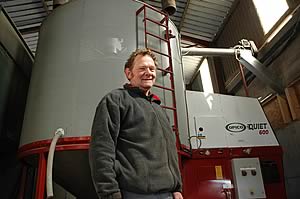 |
|||||||||
|
|||||||||||||||||||
|
|
Opico Grain Dryer allows Flexibility for Cumbrian Farmer 12/06/06 Upgrading to automatic, unmanned batch grain drying has produced a number of significant advantages on a Cumbrian farm.
Labour has been freed up to get on with other vital harvest tasks, such as baling, while the machine’s quiet operation enables drying to continue during the night if necessary. The family farming partnership of J & J & D Taylor, English Town Farm, Longtown, Carlisle, purchased an OPICO 600QF batch dryer in time for the 2004 harvest and two seasons’ use has convinced them that they made the right decision. James Taylor, who farms with his brother John and wife Doreen, estimates that the dryer handles about 700 tons of grain a year. “We had an OPICO mobile dryer previously and one of the reasons for getting another one was its mobility,” said Mr Taylor. “This allows us to move it about if we change our storage and drying policy. We did this with the previous dryer, which gave us some flexibility.” However, compared to their previous dyer, which was tractor-driven and manually operated, the new automatic model is much easier to control, said Mr Taylor. “It does precisely what you ask of it. It’s allowed us to do more batches in a day because we’ve more control over the whole operation.” Of the farm’s 660 acres, some 300 acres are arable - mainly spring barley, plus winter triticale and some oil seed rape. The remaining acreage is grassland supporting suckler cows and sheep. The soil type varies, from light land with sand and gravel, to heavy clay and peat moss. A plus factor for buying the OPICO dryer was the trade in price Mr Taylor received for the old model. “A mobile dryer has a far higher second-hand value than a static system, simply because there’s no installation involved,” he said. There was another major consideration at the time of purchase, he added. “We only have single-phase electricity here. So at harvest time we hire a self-contained diesel generator from a local plant hire company to drive the dryer. We would have had to do the same with a static system, but with this machine it’s just one cable into a generator and away you go. You could virtually dry in the middle of a field if you had to.” The first season they had the dryer, they hired a generator for four weeks. “In 2005 we tried to save on hire charges and managed to condense it into two weeks. Partly this was because the harvest was a bit drier, so the grain dryer didn’t need to do so much work. “We also put in three or four days combining before we started to dry to reduce the generator hire period. We were finished by the end of August.” The dryer is housed under cover in the grain store, and its quiet operation is an asset. “The grain store is in close proximity to the house, but it doesn’t cause any problems. “With it being electric and automatic, it allows us to dry
a lot more at night when the temperature’s cooler.” “Its important to have a holding bin so that as soon as the dryer has discharged the dried grain, it goes on to fill itself again.” Some of the grain is for home consumption, while the balance is sold through local farmers’ co-operative, Northern Grain. As far as the finished product is concerned, Mr Taylor is impressed. “The grain sample is significantly improved through the polishing effect of continuous recirculation”, he said. “We use the screen in the auger like a pre-cleaner and its amazing the amount of lights and small grains that are cleaned out of the sample.”
|
||||||||||||||||||

|
|
||||||||||||||||||
| home | agri-services | pedigree
pen | news | dairy | beef | machinery property | organisations | site map |
|||||||||||||||||||

